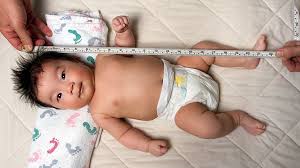
Average baby sizes through the first year
The World Health Organization (WHO) publish standard infant growth charts based on the standard growth of children in six countries, including the United States, in optimal growth environments. This includes breastfeeding.
According to the WHO's growth charts, the average lengths for male babies and female babies are as follows:
| Age | Male baby | Female baby |
| Birth | 19.69 in (50 cm) | 19.29 in (49 cm) |
| 1 month | 21.65 in (55 cm) | 21.26 in (54 cm) |
| 2 months | 23.03 in (58.5 cm) | 22.44 in (57 cm) |
| 3 months | 24.21 in (61.5 cm) | 23.62 in (60 cm) |
| 4 months | 25.20 in (64 cm) | 24.41 in (62 cm) |
| 5 months | 25.98 in (66 cm) | 25.20 in (64 cm) |
| 6 months | 26.77 in (68 cm) | 25.48 in (66 cm) |
| 7 months | 27.17 in (69 cm) | 26.38 in (67 cm) |
| 8 months | 27.95 in (71 cm) | 27.17 in (69 cm) |
| 9 months | 28.35 in (72 cm) | 27.56 in (70 cm) |
| 10 months | 28.74 in (73 cm) | 28.15 in (71.5 cm) |
| 11 months | 29.33 in (74.5 cm) | 28.74 in (73 cm) |
| 12 months | 29.92 in (76 cm) | 29.13 in (74 cm) |
These numbers are just averages. Children can be healthy at a wide range of heights. No matter how long a baby is at birth, they are likely to grow at similar rates to other babies.
This means that if a baby is born longer than average, they are likely to stay this way during their first year or two of growth.
Growth in length during the first year is almost always based on length at birth, unless a baby has significant problems with poor weight gain that makes it difficult to thrive. This means a baby can have a lot of trouble with weight gain in the first year before it affects growth in length.
Unlike weight, which doctors objectively measured by a scale, the measured length of a baby can vary based on who is doing the measuring and how much the baby is moving around at the time.
Sometimes, if it seems as though there is an unexpected change in a baby's length from one visit to the next, it can be due to differences in the measuring.
Length alone does not reveal whether a baby is healthy. Weight is also an important consideration, especially since many newborns lose some weight after birth. Doctors will also look at factors including gestational age and how much and how well a baby is eating.
Most healthy babies follow a similar growth pattern during the first year of life. After that, growth rates vary among infants, and a baby's length is not usually a good predictor of their height as an adult.

 KSA
KSA Bahrain
Bahrain UAE
UAE Qatar
Qatar Jordan
Jordan Egypt
Egypt Turkey
Turkey South Africa
South Africa




(0) Comments